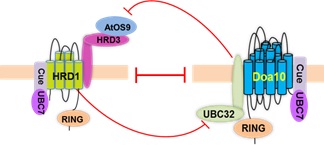ERAD (Endoplasmic Reticulum-Associated Degradation) is a special ubiquitin proteasome system located on endoplasmic reticulum (ER) and is responsible for removing mis-folded or unfolded proteins retained in ER and cytosol. Based on its importance in cell life, the ERAD activity was strictly controlled by internal level of mis-folded proteins. Under steady state, when there were fewer mis-folded proteins in cells, too-high level of ERAD activity led to the mis-regulation of proteins in cells. Therefore, some key components were down-regulated by ERAD tuning process to keep a low level of ERAD activity. However little is known in plant field.
Researchers in Prof. XIE Qi’s group from the Institute of Genetics and Developmental Biology (IGDB), Chinese Academy of Sciences, reported a reverse ERAD tuning activity in plants.
XIE’s lab focuses on the plant ERAD function. HRD1 and DOA10 complexes are two major complexes involved in ERAD in eukaryote. A previous work from XIE’s lab showed HRD1 targets UBC32 (DOA10 component) for degradation under steady state and that was the first report on ERAD tuningin plant science.
Based on these findings, they recently found a reversed ERAD tuning, in which AtOS9, a component in HRD1 complex, is targeted by UBC32. UBC32 can interact with AtOS9 and negatively regulated the stability of AtOS9.
A recent work in mouse also showed there was a similar regulation mechanism. Thus, both works revealed there is an antagonistic effect between HRD1 and DOA10 complexes in higher eukaryote and these findings deepened our understanding of ERAD tuning.
This work entitled “ERAD tuning of the HRD1 complex component AtOS9 is modulated by an ER bound E2, UBC32” was published online in Mol. Plant on Dec. 28, 2016 (doi: 10.1016/j.molp.2016.12.011), with postdoc CHEN Qian as the first author.
This research was financially supported by the Key Project Grant of Ministry of Science and Technology of China and National Postdoctoral Program for Innovative Talents.
HRD1 and DOA10 complexes antagonize each other in higher eukaryote. (Image by IGDB)
Contact:
Dr. XIE Qi
 HRD1 and DOA10 complexes antagonize each other in higher eukaryote. (Image by IGDB)Contact:Dr. XIE QiE-mail: qxie@genetics.ac.cn
HRD1 and DOA10 complexes antagonize each other in higher eukaryote. (Image by IGDB)Contact:Dr. XIE QiE-mail: qxie@genetics.ac.cn CAS
CAS
 中文
中文




.png)
